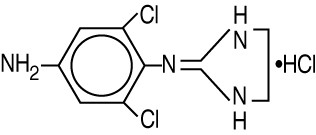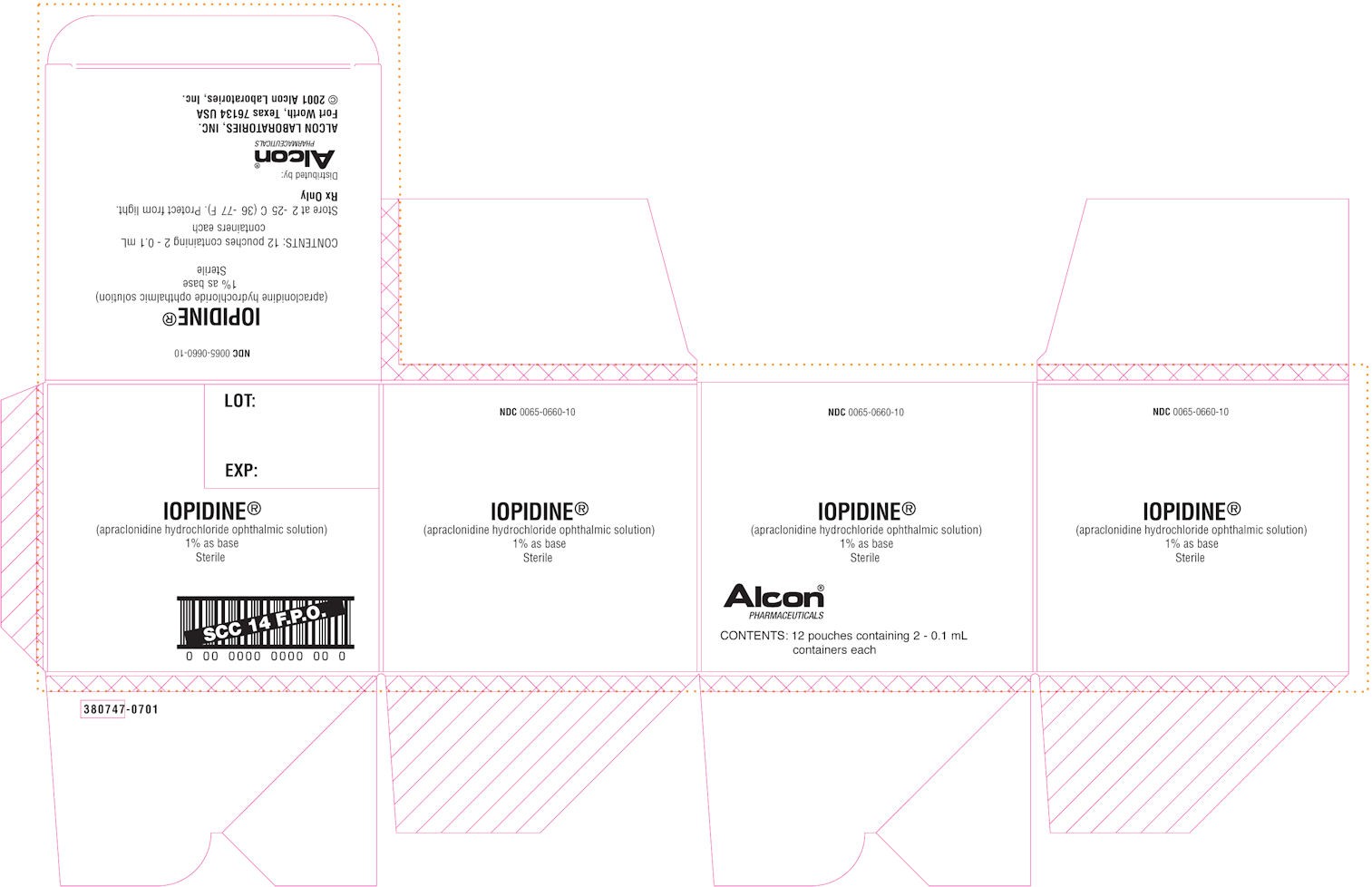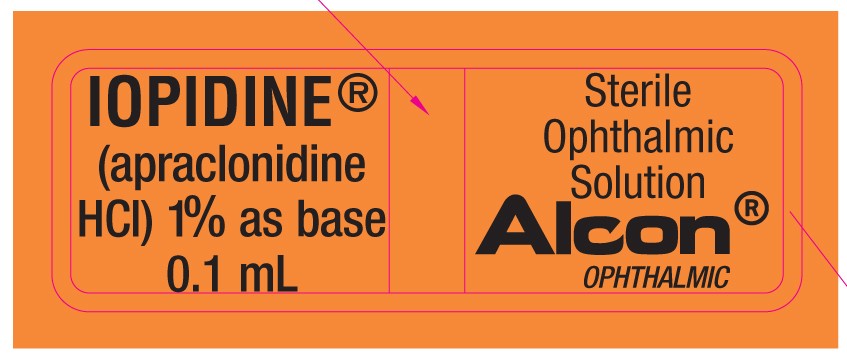IOPIDINE
Alcon Laboratories, Inc.
Alcon Laboratories, Inc.
(apraclonidine hydrochloride ophthalmic solution) 1% as baseSterile
FULL PRESCRIBING INFORMATION: CONTENTS*
- IOPIDINE DESCRIPTION
- CLINICAL PHARMACOLOGY
- IOPIDINE INDICATIONS AND USAGE
- IOPIDINE CONTRAINDICATIONS
- WARNINGS
- PRECAUTIONS
- Nursing Mothers
- Pediatric Use
- Geriatric Use
- IOPIDINE ADVERSE REACTIONS
- OVERDOSAGE
- IOPIDINE DOSAGE AND ADMINISTRATION
- HOW SUPPLIED
- PRINCIPAL DISPLAY PANEL
FULL PRESCRIBING INFORMATION
DESCRIPTION
IOPIDINE® Ophthalmic Solution contains apraclonidine hydrochloride, an alpha adrenergic agonist, in a sterile isotonic solution for topical application to the eye. Apraclonidine hydrochloride is a white to off-white powder and is highly soluble in water. Its chemical name is 2-[(4-amino-2,6 dichlorophenyl)imino] imidazolidine monohydrochloride with an empirical formula of C9H11Cl3N4 and a molecular weight of 281.6.
The chemical structure of apraclonidine hydrochloride is:

Each mL of IOPIDINE Ophthalmic Solution contains: Actives: apraclonidine hydrochloride 11.5 mg equivalent to apraclonidine base 10 mg. Preservative: benzalkonium chloride 0.01%. Inactives: sodium chloride, sodium acetate, sodium hydroxide and/or hydrochloric acid (pH 4.4-7.8) and purified water. Osmolality is 260-320 mOsm.
CLINICAL PHARMACOLOGY
Apraclonidine is a relatively selective, alpha adrenergic agonist and does not have significant membrane stabilizing (local anesthetic) activity. When instilled into the eye, IOPIDINE (apraclonidine hydrochloride ophthalmic solution) has the action of reducing intraocular pressure. Ophthalmic apraclonidine has minimal effect on cardiovascular parameters. Optic nerve head damage and visual field loss may result from an acute elevation in intraocular pressure that can occur after argon or Nd:YAG laser surgical procedures. Elevated intraocular pressure, whether acute or chronic in duration, is a major risk factor in the pathogenesis of visual field loss. The higher the peak or spike of intraocular pressure, the greater the likelihood of visual field loss and optic nerve damage especially in patients with previously compromised optic nerves. The onset of action with IOPIDINE Ophthalmic Solution can usually be noted within one hour and the maximum intraocular pressure reduction usually occurs three to five hours after application of a single dose. The precise mechanism of the ocular hypotensive action of IOPIDINE Ophthalmic Solution is not completely established at this time. Aqueous fluorophotometry studies in man suggest that its predominant action may be related to a reduction of aqueous formation. Controlled clinical studies of patients requiring argon laser trabeculoplasty, argon laser iridotomy or Nd:YAG posterior capsulotomy showed that IOPIDINE Ophthalmic Solution controlled or prevented the postsurgical intraocular pressure rise typically observed in patients after undergoing those procedures. After surgery, the mean intraocular pressure was 1.2 to 4 mmHg below the corresponding presurgical baseline pressure before IOPIDINE Ophthalmic Solution treatment. With placebo treatment, postsurgical pressures were 2.5 to 8.4 mmHg higher than their corresponding presurgical baselines.
Overall, only 2% of patients treated with IOPIDINE® Ophthalmic Solution had severe intraocular pressure elevations (spike≥10 mmHg) during the first three hours after laser surgery, whereas 23% of placebo-treated patients responded with severe pressure spikes (Table 1). Of the patients that experienced a pressure spike after surgery, the peak intraocular pressure was above 30 mmHg in most patients (Table 2) and was above 50 mmHg in seven placebo-treated patients and one IOPIDINE Ophthalmic Solution-treated patient.
Table 1
Incidence of Intraocular Pressure Spikes≥10 mmHg
| Treatment | ||||||
|---|---|---|---|---|---|---|
| Apraclonidine | Placebo | |||||
| Study | Laser Procedure | P-Value | aN | (%) | aN | (%) |
| 1 | Trabeculoplasty | <0.05 | 0/40 | (0%) | 6/35 | (17%) |
| 2 | Trabeculoplasty | =0.06 | 2/41 | (5%) | 8/42 | (19%) |
| 1 | Iridotomy | <0.05 | 0/11 | (0%) | 4/10 | (40%) |
| 2 | Iridotomy | =0.05 | 0/17 | (0%) | 4/19 | (21%) |
| 1 | Nd:YAG Capsulotomy | <0.05 | 3/80 | (4%) | 19/83 | (23%) |
| 2 | Nd:YAG Capsulotomy | <0.05 | 0/83 | (0%) | 22/81 | (27%) |
aN = Number Spikes/Number Eyes.
Table 2
Magnitude of Postsurgical Intraocular Pressure in Trabeculoplasty, Iridotomy and Nd:YAG Capsulotomy Patients With Severe Pressure Spikes=10 mmHg
| Maximum Postsurgical Intraocular Pressure (mmHg) | |||||
|---|---|---|---|---|---|
| Total | |||||
| Treatment | Spikes | 20-29 mmHg | 30-39 mmHg | 40-49 mmHg | >50 mmHg |
| IOPIDINE | 8 | 1 | 4 | 2 | 1 |
| Placebo | 78 | 16 | 47 | 8 | 7 |
INDICATIONS AND USAGE
IOPIDINE (apraclonidine hydrochloride ophthalmic solution) is indicated to control or prevent postsurgical elevations in intraocular pressure that occur in patients after argon laser trabeculoplasty, argon laser iridotomy or Nd:YAG posterior capsulotomy.
CONTRAINDICATIONS
IOPIDINE Ophthalmic Solution is contraindicated for patients receiving monoamine oxidase inhibitor therapy and for patients with hypersensitivity to any component of this medication or to clonidine.
WARNINGS
FOR TOPICAL OPHTHALMIC USE ONLY. Not for injection or oral ingestion.
PRECAUTIONS
General
Since IOPIDINE® Ophthalmic Solution is a potent depressor of intraocular pressure, patients who develop exaggerated reductions in intraocular pressure should be closely monitored.
Although the acute administration of two drops of IOPIDINE Ophthalmic Solution has minimal effect on heart rate or blood pressure in clinical studies evaluating patients undergoing anterior segment laser surgery, the preclinical pharmacologic profile of this drug suggests that caution should be observed in treating patients with severe cardiovascular disease including hypertension.
The possibility of a vasovagal attack occurring during laser surgery should be considered and caution used in patients with history of such episodes.
Topical ocular administration of two drops of 0.5%, 1% and 1.5% IOPIDINE Ophthalmic Solution to New Zealand Albino rabbits three times daily for one month resulted in sporadic and transient instances of minimal corneal cloudiness in the 1.5% group only. No histopathological changes were noted in those eyes. No adverse ocular effects were observed in cynomolgus monkeys treated with two drops of 1.5% IOPIDINE Ophthalmic Solution applied three times daily for three months. No corneal changes were observed in 320 humans given at least one dose of 1% IOPIDINE Ophthalmic Solution.
Drug Interactions
Interactions with other agents have not been investigated.
Carcinogenesis, Mutagenesis, Impairment of Fertility
No significant change in tumor incidence or type was observed following two years of oral administration of apraclonidine HCl to rats and mice at dosages of 1 and 0.6 mg/kg/day, up to 50 and 30 times, respectively, the maximum dose recommended for human topical ocular use. Apraclonidine HCl was not mutagenic in a series of in vitro mutagenicity tests, including the Ames test, a mouse lymphoma forward mutation assay, a chromosome aberration assay in cultured Chinese hamster ovary (CHO) cells, a sister chromatid exchange assay in CHO cells, and a cell transformation assay. An in vivo mouse micronucleus assay conducted with apraclonidine HCl also provided no evidence of mutagenicity. Reproduction and fertility studies in rats showed no adverse effect on male or female fertility at a dose of 0.5 mg/kg/day (25 times the maximum recommended human dose).
Pregnancy
Pregnancy Category C: Apraclonidine HCl has been shown to have an embryocidal effect in rabbits when given in an oral dose of 3 mg/kg/day (150 times the maximum recommended human dose). Dose related maternal toxicity was observed in pregnant rats at 0.3 mg/kg/day (15 times the maximum recommended human dose). There are no adequate and well controlled studies in pregnant women. IOPIDINE 1% Ophthalmic Solution should be used during pregnancy only if the potential benefit justifies the potential risk to the fetus.
Nursing Mothers
It is not known if topically applied IOPIDINE Ophthalmic Solution is excreted in human milk. Decision should be made to discontinue nursing temporarily for the one day on which IOPIDINE Ophthalmic Solution is used.
Pediatric Use
Safety and effectiveness in pediatric patients have not been established.
Geriatric Use
No overall differences in safety or effectiveness have been observed between elderly and younger patients.
ADVERSE REACTIONS
The following adverse events, occurring in less than 2% of patients, were reported in association with the use of IOPIDINE® Ophthalmic Solution in laser surgery: ocular injection, upper lid elevation, irregular heart rate, nasal decongestion, ocular inflammation, conjunctival blanching, and mydriasis. The following adverse events were observed in investigational studies dosing IOPIDINE Ophthalmic Solution once or twice daily for up to 28 days in nonlaser studies:
Ocular: Conjunctival blanching, upper lid elevation, mydriasis, burning, discomfort, foreign body sensation, dryness, itching, hypotony, blurred or dimmed vision, allergic response, conjunctival microhemorrhage.
Gastrointestinal: Abdominal pain, diarrhea, stomach discomfort, emesis.
Cardiovascular: Bradycardia, vasovagal attack, palpitations, orthostatic episode.
Central Nervous System: Insomnia, dream disturbances, irritability, decreased libido.
Other: Taste abnormalities, dry mouth, nasal burning or dryness, headache, head cold sensation, chest heaviness or burning, clammy or sweaty palms, body heat sensation, shortness of breath, increased pharyngeal secretion, extremity pain or numbness, fatigue, paresthesia, pruritus not associated with rash.
OVERDOSAGE
Ingestion of IOPIDINE 0.5% Ophthalmic Solution has been reported to cause bradycardia, drowsiness, and hypothermia. Accidental or intentional ingestion of oral clonidine has been reported to cause apnea, arrhythmias, asthenia, bradycardia, conduction defects, diminished or absent reflexes, dryness of the mouth, hypotension, hypothermia, hypoventilation, irritability, lethargy, miosis, pallor, respiratory depression, sedation or coma, seizure, somnolence, transient hypertension, and vomiting. Treatment of an oral overdose includes supportive and symptomatic therapy; a patent airway should be maintained. Hemodialysis is of limited value since a maximum of 5% of circulating drug is removed.
DOSAGE AND ADMINISTRATION
One drop of IOPIDINE Ophthalmic Solution should be instilled in the scheduled operative eye one hour before initiating anterior segment laser surgery and a second drop should be instilled to the same eye immediately upon completion of the laser surgical procedure. Use a separate container for each single-drop dose and discard each container after use.
HOW SUPPLIED
IOPIDINE (apraclonidine hydrochloride ophthalmic solution), 1% as base is a sterile, isotonic, aqueous solution containing apraclonidine hydrochloride. Supplied as follows: 0.1 mL in plastic ophthalmic dispensers, packaged two per pouch. These dispensers are enclosed in a foil overwrap as an added barrier to evaporation.
0.1 mL: NDC 0065-0660-10
STORAGE:
Store at 2°- 25°C (36°- 77°F).
Protect from light.
Rx Only
U.S. Patent No. 5,212,196
©2001, 2004 Alcon, Inc.
Made in France
426670
Manufactured for:
ALCON LABORATORIES, INC.
Fort Worth, Texas 76134 USA
Manufactured by:
Laboratoires Alcon, S.A.
F-68240 Kaysersberg,France
249055-1204
Revised: December 2004
PRINCIPAL DISPLAY PANEL
NDC 0065-0660-10
IOPIDINE®
(apraclonidine hydrochloride ophthalmic solution)
1% as base
Sterile
CONTENTS: 12 pouches containing 2 - 0.1 mL
containers each
Store at 2 - 25 C (36 - 77 F). Protect from light.
Rx Only
Distributed by:
Alcon®
PHARMACEUTICALS
ALCON LABORATORIES, INC.
Fort Worth, Texas 76134 USA
©2001 Alcon Laboratories, Inc.


IOPIDINEapraclonidine hydrochloride SOLUTION
| ||||||||||||||||||||||||||||||||||||||||||||||||||||||||||||||||||